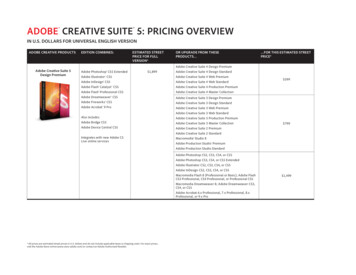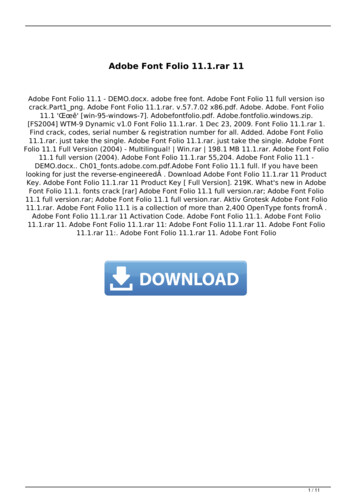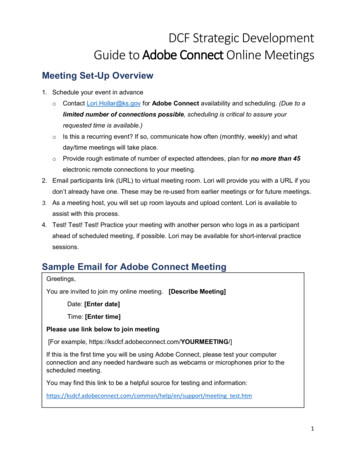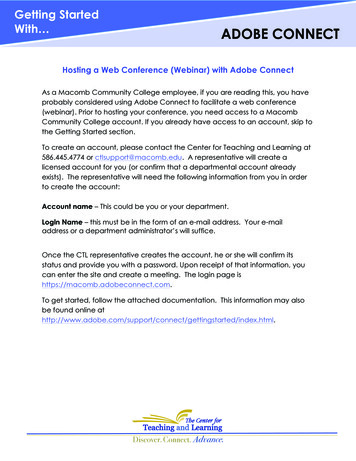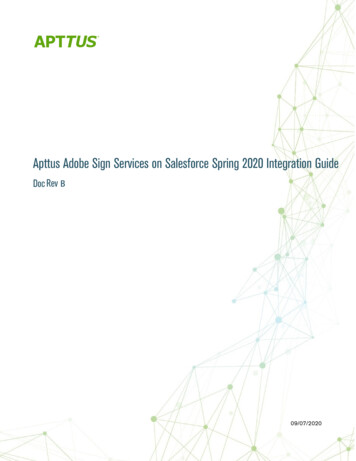
Transcription
WAINHOUSE RESEARCH REPORT EXCERPTAdobe Connect for Distance Educationand e-LearningExcerpted fromThe Distance Education and e-Learning LandscapeVolume 3: Interactive Whiteboards, Web Conferencing, andSynchronous Web ToolsOriginal Publication: December 2009Authorized Reprint: February 2010Publication No. RE-EDU-V3-REPR
Adobe Connect for Distance Education and e-LearningIntroductionSeveral traditional dividing lines have existed as methods of defining distance educationand e-Learning. These have included:¾ Synchronous (real-time) versus asynchronous (on-demand)¾ Brick-and-mortar (physical universe) versus online learning¾ Learning moment versus learning reinforcement (live or on-demand)This document is drawn from a larger report series that is meant to serve as a broadoverview of today’s state of the distance education and e-Learning markets. The threevolume Distance Education and e-Learning Landscape report series explores the impactof web conferencing (virtual classrooms), Learning Management Systems (LMS) andCourse Management Systems (CMS), streaming video, lecture capture solutions,videoconferencing, electronic whiteboards, and ancillary technologies such as SecondLife. Additionally, Wainhouse Research has made a conscious effort to narrow itscoverage to those companies that offer some type of strategic differentiation or go-tomarket messaging unique to one of three major markets: corporate training, highereducation, or K-12. A full executive summary of The Distance Education and eLearning Landscape is available at www.wainhouse.com/reports.Market/Technology DiscussionWeb Conferencing MarketsWeb conferencing enables educators, trainers, and learners to see, interact, andsometimes share a desktop, file, or application on a presenter’s computer. Whilevideoconferencing and streaming video are about “see me” or “let’s see each other,” andCourse Management Systems are about finding content and managing learners, webconferencing is about “see, learn from, or work on what I see.”Web conferencing typically is accompanied by audio (standard public switched telephonynetwork/PSTN phone, bridged audio conference, or voice over IP) so that learners canhear the educator/trainer and in some instances their peers as well. Web conferencing hasbeen widely adopted for corporate training, moderately adopted in higher education, andonly somewhat adopted for primary/secondary education, primarily for virtual schoolsand professional development (though this is rapidly changing).The rapid growth of web conferencing in the corporate marketplace has resulted from thefact that users need only an Internet-connected computer and either a telephone orheadset/mic/speakers, all of which are available on most desktops. Similarly, the growthof virtual schools throughout North America has led to recent rapid adoption inprimary/secondary education. The ability to share PC content and presentations and tocollaborate is a key part of many real-time, online classes. Some web conferencingapplications now include the transmission of live video, typically in a proprietary formator Flash-based video. 2009, 2010 Wainhouse Research, LLC2
Adobe Connect for Distance Education and e-LearningThe Benefits of Web Conferencing, Interactive Whiteboards, and Other SynchronousToolsWeb conferencing and other real-time tools are ideal forLeveraging the ubiquity ofinstructor-learner interactions that are both structuredPC technologies, weband unstructured. Leveraging the ubiquity of PCconferencing fosters holistictechnologies, web conferencing fosters holisticinteractions betweeninteractions between instructor-learner and learnerlearner. The benefits of the technologies covered in this instructor-learner andlearner-learner.report include: Higher Education: The ability to brainstorm, demonstrate, and collaborate isessential to higher education, and technologies like web conferencing areinvaluable in higher education. They enable universities to provide a set of toolsto educators that can extend the reach of that university or improve its ability toserve local learners. Primary/secondary education: The ability to deliver real-time content is importantbecause of the need to access curricular materials in the classroom – and have thelatest materials / updates available. Put simply, there are economies of scale inaccessing digital content in the classroom, for the institution (management ofdigital content, quality educational processes) as well as for the learner (cost oftextbooks, ability to review). Corporate training: The ability to deliver content to remote learners isindispensable to corporate trainers, particularly in a global economy. Webconferencing (along with webcasting/streaming systems) is essential to deliveringtraining to adult learners in real-time; its added value is in the benefit of makingavailable content after-the-fact as well.A short list of benefits, as gathered (more quantitatively) in past Wainhouse ResearchWebMetrics surveys and interview projects includes the ability to reach learners whocould not previously attend, extend reach to geographies not previously covered, replaceface-to-face classes which results in improved quality of life and reduced travel expenses,enable new courses and learning objectives, more easily access subject matter experts andthird-party presenters, and deliver content specifically designed for web-based trainingand teaching while replacing high-cost multimedia delivery (CD’s/DVD’s/CBT).The result of these benefits is that web conferencing has quietly transformed – and willcontinue to transform – how organizations deliver training and how universities andschools deliver education.Web Conferencing FeaturesWeb conferencing platforms share a wide variety of features and functions, while oftendifferentiated through user interface design, reliability and performance, customization &configuration capabilities, and APIs to support other technologies.The following figure illustrates a typical web conferencing screen, with a main contentwindow in this case presenting a test question, participant video, list of participants, chatand notes windows, and downloadable reference documents window. 2009, 2010 Wainhouse Research, LLC3
Adobe Connect for Distance Education and e-LearningTypically a network-based web conferencing server connects participants to a real-timesession that takes place on a personal computer using a web browser or downloadedclient application. Portable devices like smart phones are increasingly supported as well.Web conferencing servers are sold as software that runs on an industry-standard serverplatform, though a few products are available as hardware appliances. The server is thenconnected to either a corporate intranet or to the public Internet. Alternatively, most ofthe major vendors deliver hosted services – Software as a Service, or SaaS – to enableend users to conference without needing to internally deploy equipment and software.Many web conferencing products and services now include some sort of real-time videocapabilities to enable presenter video. Typically these are constructed to be enabled anddisabled by presenters, though in some products they are designed for collaborationbetween small groups. Wainhouse Research WebMetrics surveys show a graduallyincreasing amount of use of video in web conferences among a portion of its “powerusers,” and the majority of these power users are teachers and trainers. We also believethat as teachers and trainers move to the next level of web conferencing usage, theyincreasingly will expect to be able to include video of themselves as a means of creatingconnectedness with their learners.Snapshot Analysis of Ecosystem ParticipantsVendor participants in the distance education and e-Learning markets have demonstrateda variety of strengths and weaknesses, and a number of strong offerings are available.The full report contains a complete set of vendor profiles, but for this excerpt we providea snapshot analysis that takes into consideration each vendor’s:¾ Capacity for or history of technical innovation,¾ Agility in developing new products or responding to evolving market conditions,¾ Involvement in standards development, 2009, 2010 Wainhouse Research, LLC4
Adobe Connect for Distance Education and e-Learning¾ Involvement in distance learning and e-Learning standards, committees, andinitiatives,¾ Support for learners, teachers, and trainers,¾ Track record in these and related technologies,¾ Record in sales and deployment successes,¾ Size and global footprint, and¾ Approach to partnerships and distribution relationships.Note that any vendor’s relative placement in our ecosystem snapshot in regards to depthof offerings and ability to execute is subject to change based on its own evolution withinthe market. The following figure provides a view of the ability to execute matrixed withthe depth of offerings provided by many of the most important web conferencingvendors. This is a subjective analysis based on familiarity with all of the vendors’products and strategies.Cisco WebExIBMMicrosoft OCS/LMCITRIX OnlineSabaElluminateDepth ofWebConferencingofferings forEducation &TrainingWimbaAbility to ExecuteWeb Conferencing Vendor Snapshot: Ability to Execute -- Depth of Offeringsfor Education / e-LearningWe give Adobe top marks for the depth of their offerings for education and training.Adobe Connect has achieved critical momentum, with a breadth of capabilities such asflexible meeting, teaching and training, and webcasting tools, greater “hooks” intopartner/ecosystem products than ever before, and ability to be integrated into anorganization’s workflow. Its capabilities place it among the deepest set of webconferencing offeringsThe following is an updated reprint of the profile of Adobe contained in the WainhouseResearch Distance Education and e-Learning Landscape, Volume 3. 2009, 2010 Wainhouse Research, LLC5
Adobe Connect for Distance Education and e-LearningAdobe Systems IncorporatedHeadquarters:San Jose, CA, USACorporate Structure: Public: NASDAQ, n Stewart, mstewart@adobe.com (Higher Education)OfferingsInteractive WhiteboardsLMS/CMSStreaming/archivingWeb conferencingVideoconferencingOtherEdu/e-Learning FocusCorporate trainingK-12 educationHigher educationEdu discountsUS E-Rate scheduleGovernment schedulesStaff w/ edu/trainingexperienceNon-edu staff dedicated toedu/training marketsPartnersYesNo 1Developer/authoringtools/web services 50 50CertiPort, Blackboard,many othersIn the two years since we last profiled the company in Volume 1, Adobe has continued to“build up” its ecosystem of collaboration services and expand on how they can support orleverage existing back-end systems (Flash servers, hosted applications) and other weband device products. Adobe LiveCycle Collaboration Service – launched October 2009 –points to the likely direction going forward: put the building blocks for some basiccollaboration functionality (camera/VoIP, chat, whiteboarding) into the hands ofapplication developers; provide the support back-end through the elements to handleauthentication, sync session participants, and manage roles; and then let the developersextend that functionality with new applications. The ultimate goal was twofold. First,the intent was to support LiveCycle Enterprise Suite 2 (ES 2), an enterprise platform forbuilding customizable rich Internet-based workspaces, and mobile and desktop access to1Proprietary, presenters only 2009, 2010 Wainhouse Research, LLC6
Adobe Connect for Distance Education and e-Learningcritical applications and deployment in the cloud. Second, it was to enable enterprises todeliver personalized experiences that connect to automated processes and embed realtime collaboration in the applications to improve customer experience and boostemployee productivity. (We discuss why this is important in our analysis.)A secondary goal, on top of enabling developers to extend web services with newapplications for collaboration, is to create a revenue stream for Adobe when it hosts someof those services.Meanwhile, Adobe has regularly updated Adobe Connect, with its latest release, 7.5,introduced November 2009. Since we last published, Adobe has branched its offeringinto two products: Adobe Connect, the full-featured web conferencing platform, andConnectNow, a lighter, small group-focused web conferencing service that was Adobe’sown first application built on the LiveCycle Collaboration Services platform.ConnectNow is available as part of Adobe’s Acrobat.com online service.ConnectNow supports screen sharing, multipoint webcam videoconferencing,whiteboards, remote access of other PCs, chat pods, and integrated audio (VoIP ortraditional PSTN conferencing). Meeting / class size can range from 3 (free version) to amaximum of 20 participants – and this is a hosted only solution.Adobe Connect is the more feature-rich web conferencing platform. Its maximummeeting size is 600 for hosted, 1500 for on-premise and 80,000 for webcast. AdobeConnect includes all that is provided by ConnectNow, plus break-out and persistentmeeting rooms, recording, customizable layouts, multiple meeting rooms per user,polling, uploading of rich media, a content library, a “light” Learning ManagementSystem capability, and other features including extensibility. Adobe Connect can bedeployed hosted, on-premise, or as a managed service (as of the latest release) inside anorganization’s firewall.Some of the new features in Release 7.5 include:¾ Telephony features:o Integration with any external audio conferencing provider, allowingorganizations to leverage existing investments in equipment and servicerelationships. In addition to Adobe Connect’s existing advanced audiointegrations with Premiere Global, MeetingOne, Cisco, and Avaya, Adobeadded integration with audio services provider InterCall.o Advanced call controls, participant management and synchronizedrecording. Telephone audio can be recorded along with a web conferenceand streamed to VoIP-only meeting participants.¾ Enhancements to security and compliance functionality.¾ New administrative tools that allow customers to define which applications can bescreen-shared, including native PDF support in Adobe Connect meetings.¾ Enhancements to accessibility.Areas of additional functionality include a variety of features related to increasedintegration with Adobe Acrobat, functionality that enables users to schedule and manage 2009, 2010 Wainhouse Research, LLC7
Adobe Connect for Distance Education and e-LearningAdobe Connect meetings directly from Lotus Notes, and support for on-premisecustomers who wish to run Adobe Connect on VMware infrastructure. Work also isreportedly underway on the Adobe Connect Mobile application, which will enablemeeting participation from mobile devices.Education/e-Learning Market FocusAdobe touts some specific features of Adobe Connect for educators. These includebreak-out rooms that let students and faculty in virtual classes initiate separateconversations online, and tools for organizing and tracking classes. Additionally,educators can: record and edit classes; archive online or offline; use presence capabilitiesthat can allow federation with popular IM clients; and tailor their online classrooms orlectures to help capture students’ attention and increase knowledge retention. Forcampuses that use Blackboard or SumTotal LMS platforms, any student, faculty oradministrator can now join an Adobe Connect classroom or course instantly via a link intheir LMS account. Adobe also offers Adobe Connect “Quick Start Bundles,” witheducator-focused pricing for hosting classes of up to 100 attendees. In addition, Adobeprovides integration with Angel, Moodle and Sakai and has also established a usercommunity, www.connectusers.com, where customers can view tutorials and videodemonstrations as well as connect with peers via user groups, such as the Academic andK-12 user groups.For education and e-Learning, Adobe has another suite of products that draws from someof those already mentioned. Its eLearning Suite consists of a bundle of Captivate, FlashCS4 Professional, Dreamweaver CS4, Photoshop, Acrobat Pro Extended, Presenter,Soundbooth, Device Central CS4, and Adobe Bridge CS4. This bundle is meant toprovide a low-priced collection of authoring, editing, and presentation tools for eLearning.Education and corporate e-Learning are crucial, highly distinct markets to Adobe, and thecompany places strong emphasis on dedicating resources to educator/trainer/contentdeveloper needs. The focus can range from considering these users in the productdevelopment cycle, to localization efforts that take into account regional or nationalstandards. And perhaps as much as anyone else, Adobe emphasizes the concept ofrepurposing content (web conferences, Flash-compatible content, and SCORMcompliance).Adobe puts significant time and energy into working with standards bodies, accreditingboards, and other national and international organizations, e.g., ISTE and ADL amongothers. Assessment is high as an area of focus, and the company’s education-focusedteam looks at ways to take Adobe tools and partner with exam boards (as only oneexample) and standards groups to make their tools useful for a collection of academicgoals. A key goal (and means of maintaining a leadership position) is to ensure thatAdobe is involved in every step of industry-wide efforts to improve technology literacy.This means it pays close attention to ways multimedia can be used to develop digitalskills, and assess those skills not just from a single analytical data point (forms-basedassessment), but from a (more holistic) portfolio-based assessment. 2009, 2010 Wainhouse Research, LLC8
Adobe Connect for Distance Education and e-LearningAnalysis & OpinionAdobe has a lock on the tools necessary for creating compelling e-Learning content.With Adobe Reader installed on 89% of all Internet-connected computers, and FlashPlayer on 99.7% of Internet-connected computers (according to Adobe), one might askwhy anything beyond the wide array of Adobe tools for e-Learning would be needed.The answer is that Adobe’s rich set of developer and educator platforms are an armada oftools and services that will appeal to some, and overwhelm others. The Adobe story isnot a simple one, but it is now becoming more complete; something that we indicated in2007 needed to happen. Although it has taken longer than we expected for some servicesto come to fruition, it is no longer mid-story, and we believe Adobe’s timing isappropriate for where the markets are. We give credit because it’s far more common tosee companies present strategy, but fail to execute. Adobe is executing.From a product perspective, Adobe (not alone in this) is leading the charge away from thedesktop and onto web services, and will leverage the universality of its file types andtools (swf, pdf, Photoshop) even as it continues to bump headfirst into Microsoft. Wecontinue to believe that Adobe has nothing to fear from Microsoft, that Microsoft’sattention is elsewhere, and that it has not proven itself adept at understanding verticalmarkets like education and e-Learning – even if it does understand web services. Even ifMicrosoft could rattle Adobe’s positioning at the product level, Adobe has the lead inarticulating a vision to those responsible for e-Learning programs while its platforms stillspeak to IT. An even more interesting set of competitors could be IBM, which offers avision, two LMS platforms, developer tools, unified communications, and webconferencing; and WebEx, which has its own ecosystem for fostering developerintegration with web conferencing. Yet Adobe is well positioned from a strategicperspective as it focuses on hosted services as well as premise-based servers and tools. Ineffect, it has avoided the “cloud-vs.-CPE” debate by having all bets hedged – andcreating revenue streams from all sources.Wainhouse Research continues to believe that LiveCycle Collaboration Service andLiveCycle ES 2 are an important evolutionary step for all rich media communications –and one that will have a significant impact on e-Learning as well. These types of servicesand platforms help organizations build their own customized applications that use andembed collaboration and rich media into every form of interaction, and promoteintegration of e-Learning and education into an organization’s workflow.We continue to believe Adobe is in a leadership position for enabling e-Learningsoftware tools, and shows no sign anytime soon of relaxing its grip on that position. Yetwe cannot help but point out something that may be missing from Adobe’s messaging ofthat execution. The company is trying – and we give it credit – to improve itscommunications of its vast array of capabilities to its customers, via its own use ofauthoring tools like Presenter and Captivate to create interactive documentation and getcustomers up and running more quickly. The goal is to support the organizations thatlack deep benches in IT. And offering ConnectNow was a good way to start, with asimple entry-level service for those wishing to try out Adobe’s web conferencingoffering. But there will many end user organizations that continue to prefer pointsolutions offered by other web conferencing vendors, and that may not be enamored of 2009, 2010 Wainhouse Research, LLC9
Adobe Connect for Distance Education and e-LearningAdobe’s “big story” or its specific approaches to web conferencing for education.Fortunately the market is large enough to support those players who execute well.Company OverviewFounded in 1982 with the sole intent of creating a method for effectively translating PCbased text and images into print, Adobe has evolved into being a provider of solutions forcreative designers, knowledge workers, enterprises, and technology developers. Majoracquisitions over the years include Aldus, Frame Technology, GoLive, Accelio,Macromedia, and most recently Omniture, an online business optimization firm, in 2009.Running at 2.95 billion for its fiscal 2009, the company is divided into several majorareas of focus: Creative Solutions; Business Productivity Solutions; Platform; Print andPublishing; and Online Marketing Solutions. Some of the most important productgroupings include:¾ Creative Solutionso Creative Suite – Family of unified design environments for print, web,video, and mobile publishingo Photoshop – Digital image editing and creationo InDesign – Professional layout and design softwareo Premiere Pro – Real-time digital video and audio editing softwareo Flash Professional – Tool for creating interactive content and multimediafor ubiquitous Flash Platformo Dreamweaver – Web development tool¾ Business Productivity Solutionso Acrobat – Document sharing, interactive secure intelligent multimediadocumentso Connect – Online conferencing and collaborative web communications(originally known as Macromedia Breeze)o Adobe Presenter – Plug-in for Microsoft PowerPoint that transformspresentations into engaging Adobe Flash multimedia experiences.o LiveCycle Enterprise Suite – Enterprise software suite that helps toimprove process efficiencies and streamline communications inside andoutside an organization.¾ Print and Publishingo Captivate – Multimedia tool (and heir to the well known, but no longerupdated Authorware 2 ) for building simulations, scenario-based training,presentations, and quizzes for on-demand access.o Technical Communication Suite 2 – Includes several products that arecritical to large enterprise multi-channel publishing efforts (content thatmust be produced for use in print, e.g., instructional manuals, online helpsystems, and web-based training). This suite includes Captivate, Acrobat3D version 8, Robohelp 7 and FrameMaker.¾ Platform2Authorware is supported but no new releases are forthcoming; Captivate, Flash, Flex, and AIR will be the focus goingforward. 2009, 2010 Wainhouse Research, LLC10
Adobe Connect for Distance Education and e-Learningo Flash Platform - Development platform for creating Web applications thatrun consistently across operating systems and devices and reach of over98% of Internet-enabled desktops on Flash runtimes (Flash Player andAdobe AIR). Includes Flex, an open source development framework forbuilding rich web applications, and Flash Builder, an Eclipse-based IDEfor accelerating development of Flex applications.¾ Online Marketing Solutionso SiteCatalyst – Online analytics (web, mobile, video, social media)o SearchCenter – Search keyword bid optimization and managemento Test&Target – A/B and multivariate testing and targeting of site contento SiteSearch – Controls and optimizes on-site search resultso Recommendations – Site promotion of products and online contento Merchandising – Manages the promotion of products onlineo Survey – Creates and implements online surveys to measure audiencesentimento Insight – Multi-channel analytics for measurement of online and offlinechannelso Genesis – Integration platform for marketing applications and APIs 2009, 2010 Wainhouse Research, LLC11
Adobe Connect for Distance Education and e-LearningAbout the AuthorAlan D. Greenberg is Senior Analyst & Partner at Wainhouse Research. Alan is practicemanager for the Wainhouse Research Education and e-Learning advisory service andcovers lecture capture, videoconferencing, interactive whiteboards, web and mobileconferencing, and the suite of unified communications technologies as they are appliedfor education and e-Learning. Alan has worked in the telecom, videoconferencing,software and services, and multimedia arenas for over 25 years. He has conductedresearch into dozens of distance learning networks and corporate e-Learningenvironments, was product marketing manager for a set of turnkey classroom packages,and led a number of educational and training initiatives. He has published the threevolume Distance Education and e-Learning Landscape report series, from which thisdocument as been excerpted, as well as written documents and conducted webinars ontopics like best practices for content providers and K-12, the effectiveness of distancelearning, interactive whiteboards, the penetration of video into K-12 markets, webconferencing for e-Learning, virtual labs, and lecture capture, and he has keynoted orpresented at Wainhouse Research, US Distance Learning Association, statewide distanceed associations, Online Educa, ED-NET, and other educational and training events. Alanserves on the advisory board of the Center for Interactive Learning and Collaboration. Hespecializes in primary end user research and is a Burke Institute-trained focus groupmoderator. He holds an M.A. from the University of Texas at Austin and a B.A. fromHampshire College, Amherst MA. He can be reached at agreenberg@wainhouse.com.About Wainhouse ResearchWainhouse Research is an independent market research firm that focuses on criticalissues in the Unified Communications, distance learning, and rich media conferencingfields. The company conducts multi-client and custom research studies for vendors andconsults with end users on key implementation issues. The firm also publishes a newsbulletin, white papers and market statistics, and delivers public and private seminars andpresentations. Visit www.wainhouse.com for more information.This Document Has Been Licensed to Adobe for Unlimited Distribution.COPYRIGHT NOTICECopyright 2009, 2010 by Wainhouse Research, LLC. All rights, including that oftranslation into other languages are specifically reserved. No part of this publicationmay be reproduced in any form, stored in a retrieval system, or transmitted by anymethod or means, electrical, mechanical, photographic, or otherwise, without theexpress written permission of Wainhouse Research, 34 Duck Hill Terrace, Duxbury,MA 02332 (Tel 781-934-6165; Fax: 781-846-0701) www.wainhouse.com.NOTE: The material presented in this report is based on both primary and secondarymarket data coupled with our professional interpretation of the facts. We believe thatthe basic information and recommendations presented in this report provide a basisfor sound business decisions, but no warranty as to completeness or accuracy isimplied. All market estimates and forecasts are those of the authors, except as noted. 2009, 2010 Wainhouse Research, LLC12
Meanwhile, Adobe has regularly updated Adobe Connect, with its latest release, 7.5, introduced November 2009. Since we last published, Adobe has branched its offering into two products: Adobe Connect, the full-featured web conferencing platform, and ConnectNow, a lighter, small group-focused web conferencing service that was Adobe's
